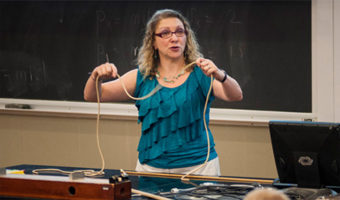The Physics & Astronomy Colloquium Series presents Nancy Sandler of Ohio University, Department of Physics & Astronomy on “Flatland that folds and oscillates: making wrinkles and drumheads with graphene ” on Friday, October 14, at 4:10 p.m. in Walter 245.

Dr. Nancy Sandler
Abstract: In his famous speech “There’s Plenty of Room at the Bottom”, Richard Feynman [1] talked about the possibility of ‘manipulating and controlling things on a small scale’. Since then, much progress has been done towards developing techniques and materials that can be used at, and characterized by ‘small scales’.
For materials, the isolation of graphene and other compounds with monoatomic thicknesses in 2004 represented a giant step in this direction. Graphene has shown to be a seemingly inexhaustible source of new and intriguing phenomena. From Dirac particles, which opened studies of QED-like physics in a condensed matter setting, to quantum spin-Hall, graphene is now part of a genuine ‘Legoblock set’ of two dimensional materials that is actively investigated in search of even more exotic phenomena.
After the initial years dedicated to improve sample fabrication, preparation and characterization, we are beginning to manipulate graphene membranes with an exquisite level of control.
In this talk, I will discuss the consequences for electron dynamics when a graphene membrane is pulled, folded or transformed into a vibrating drumhead. I will show how the coupling between mechanical (strain) and electronic degrees of freedom produce subtle effects that can be understood in terms of simple semi-classical pictures. Many of these exciting findings can be extended to other two-dimensional materials or to heterostructures built by their combinations rendering compounds with unexplored properties and functionalities.
[1] APS Annual Meeting, Caltech, 1959. Caltech’s Engineering and Science Library.















Comments